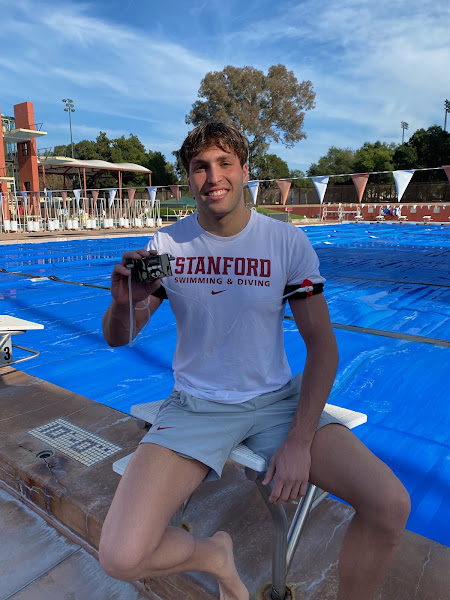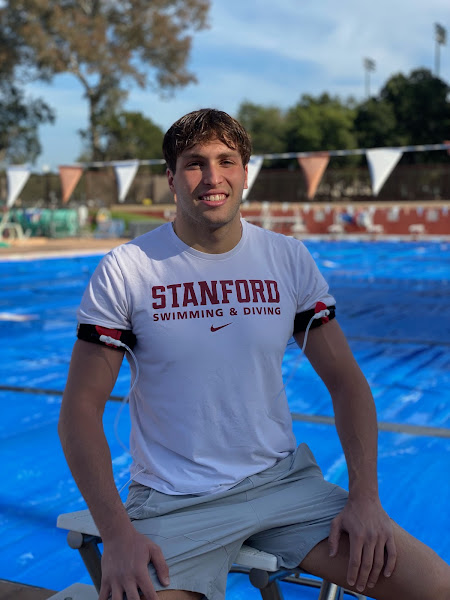 Andrew Matejka is a 6'-7" (200.6 cm) junior at Stanford University, a double major in history economics.
Andrew Matejka is a 6'-7" (200.6 cm) junior at Stanford University, a double major in history economics.Originally from Wellesley Hills, Massachusetts, he is one of America's fast middle distance freestylers - and looking to get faster. With a newly minted dual citizenship of the Czech Republic, he is looking forward to possibly competing at the 2024 Paris Olympic Games.
Andrew may have the edge now to realize his dream. He was first introduced to KAATSU in high school by his club coach Chris Morgan at the Gator Swim Club.
Andrew and his brothers - Matthew, Benjamin and Owen - are all hard-working athletes. Matthew rowed at Yale, Ben was a cross country runner at Dartmouth, and Andrew spends his time training and competing for the renowned Stanford University swim team. The Matejka brothers know - and welcome - hard work.
But Andrew has a not-so-secret weapon: he uses KAATSU equipment. Andrew uses for performance enhancement in an innovative way: for recovery. After his intense training sessions on the Stanford campus and between his individual swims at dual meets and invitationals, he puts his pneumatic KAATSU bands on his arms and does KAATSU Cycle sets. A metabolic flush results and he is ready for his next workout or race.
 KAATSU not only makes Andrew feel more recovered than a normal "swim-down", but KAATSU also helps him feel mentally prepared for his next bout of intensity. The first time he used KAATSU at Stanford, he set his personal mid-season best times.
KAATSU not only makes Andrew feel more recovered than a normal "swim-down", but KAATSU also helps him feel mentally prepared for his next bout of intensity. The first time he used KAATSU at Stanford, he set his personal mid-season best times. The KAATSU recovery of 30 seconds of pressure followed by 5 seconds of release - performed automatically, repeatedly, and progressively but in incrementally higher pressures - is the same protocol that hundreds of Olympic medalists in a wide variety of sports - from wrestling to track, from ski jumping to swimming - have followed since the 1988 Seoul Olympic Games.
What Andrew finds is most useful is that his KAATSU device is portable. Its compact so this enables convenience: he can take it with him around campus, in the team bus, in airports, and in his school apartment in addition to using it at the pool and training gym.
Andrew says, "With so many hours spent per week in the pool, weight room and classroom while pursuing my studies at Stanford, I used to feel like I didn't always have time to adequately recover. KAATSU has helped solve that problem. KAATSU allows me to spend time recovering from my grueling workouts from the comfort of my dorm room or even while studying in the library. I couldn't be more excited to partner with KAATSU as I pursue the highest levels in competitive swimming."
Andrew cuts an imposing figure wherever he goes while his ubiquitous KAATSU Air Bands helps stand him apart even further.
Matejka started his use of KAATSU under the director of Chris Morgan, an Olympic coach and the Head Coach of Gator's Swim Club in Massachusetts where Matejka trained in high school.

Morgan recalled, "We work on speed, strength and stamina every workout at the Gator's Swim Club. Back in 2016, our swimmers began KAATSU Aqua, an innovation to our entire training regime that has resulted in unprecedented drops in time."
Over a 3-month period, some of the swimmers' improvements included:
Henry Gaissert (17 years old)
• 100 freestyle: from 47.0 to 44.8 (44.1 relay split)
• 100 butterfly: from 52.4 to 49.8
Maddie Wallis (16 years old)
• 100 backstroke: from 57.1 to 54.9
• 200 backstroke: from 2:07.9 to 2:00.3
Johnny Prindle (17 years old)
• 100 freestyle: from 48.1 to a 45.9 relay split
• 200 freestyle: from 1:47.2 to 1:41.5
• 100 breaststroke: from 59.0 to 57.5
Morgan continued, "What is our secret?
In a word, KAATSU. KAATSU is what we use to gain specific strength in order to improve speed and increase stamina in the water.
We use very specific and customized pressures with carefully engineered pneumatic bands used in short durations. These pressures are specific for each athlete that can vary from day to day and workout to workout. Those specific pressures, that vary from athlete to athlete, are how our athletes have maximized the benefits of KAATSU.
I learned how we could replicate 'race pain' without the need for traditional time-consuming sets in the pool by using the KAATSU bands. By engorging the vascular tissue in the muscles in blood. In addition and equally as important, Andrew and his Gator teammates used KAATSU for recovery, too.
We use KAATSU to quickly recover sore shoulders and to overcome overuse injuries without ice or any kind of medical procedures. We use the KAATSU Cycle modality that starts off with lower pressures and gradually builds up to higher pressures. These protocols are the same protocols that are used by Olympic gold medalists and members of the 2014 Sochi Winter Olympians and 2016 and 2020 Summer Olympic athlete. Andrew learned long before he got to Stanford how to use the KAATSU Cycle modality between his races and between his preliminary heats and final races during a multi-day event to help him.
For 'race pain' training with the KAATSU bands, our sets can range from 10 x 15m breakouts to 10 x 50 at a specific pressure."
So Andrew has a lot of experience - in training and in competition - that he can share with others.".
Copyright © 2014 - 2022 by KAATSU Global
No comments:
Post a Comment